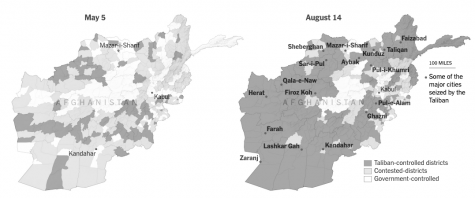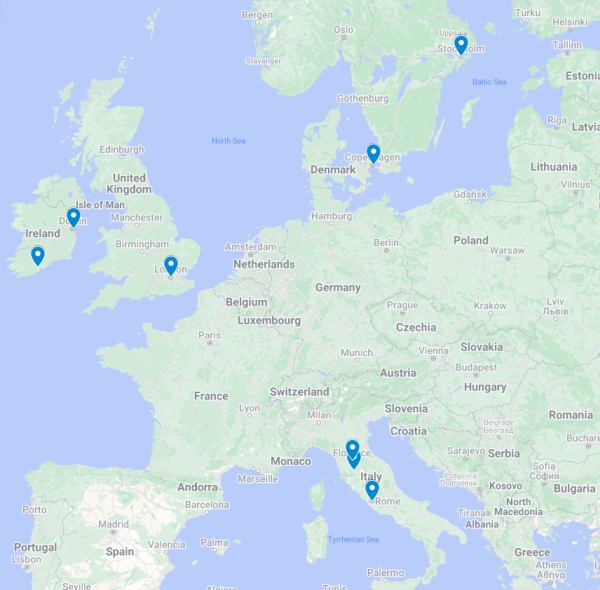U.S. pulls out of Afghanistan, Taliban takes charge

These maps display the increase in Taliban control among regions of Afghanistan from May 5 to Aug. 14.
In mid-August 2021, the Taliban took control of the country of Afghanistan in a much shorter time period than originally anticipated by the United States government.
The Taliban emerged in northern Pakistan in the early 1990s in response to the withdrawal of Soviet troops from Afghanistan. By 1998, the Taliban had control of nearly 90% of the country.
According to BBC, the organization was established to restore peace and security to the country, as well as enforcing their own version of Islamic law once they were in power.
At first, the idea of their influence was widely accepted by Afghans, but soon became threatening when they introduced punishments that aligned with their interpretation of Sharia Law. Some of the punishments included in their regime were public executions for murderers and adulterers, and amputations for those who were found guilty of theft.
Additionally, the same article addressed gender standards in Afghanistan. The Taliban’s beliefs spread to the way that men and women were perceived in the country.
Men were required to grow out their beards, and women were expected to wear burkas.
These beliefs continued to spread throughout other regions of daily life in the country, including entertainment and education. Television, music and cinema were banned. The Taliban also disapproved of education given to girls aged 10 and over.
As a response to the threat of terrorism in Afghanistan, the United States invaded Afghanistan to ensure that terrorist organizations, such as Al Qaeda and the Taliban were not able to make Afghanistan their safe haven.
Between the years 1999 and 2021, United States troops remained stationed in Afghanistan to fight the war on terror.
Back in 2001, the U.S. troops successfully removed the Taliban from power.
On October 7, 2001, the Taliban regime collapsed following a U.S. military coalition.
Despite this collapse, the Taliban continued to gain new members and built up their influence throughout the Middle East.
After a string of attacks by the Taliban between the years of 2012 and 2016, the U.S. sought out a peace deal with the Taliban in 2020.
Following this agreement, current President Joe Biden announced in April 2021 that all American forces would be withdrawn from the country before Sept. 11, 2021, the 20th anniversary of 9/11.
In a press conference on April 14, 2021, President Biden addressed this issue.
“It’s time to end America’s longest war,” President Biden said.
Since Aug. 14, nearly 105,000 people have been evacuated from Afghanistan. At first, US intelligence analysts predicted that it would take several weeks before Afghanistan’s civilian government in the capital fell to the Taliban.
In reality, a majority of the country fell to the Taliban in just a few days.
As the Taliban neared Kabul, the capital of the country, Afghan President Ashraf Ghani fled the country.
Once in a safe location outside of Afghanistan, the Afghan President spoke on the issue.
He started to believe that if he did not leave the country, then, “countless patriots would be martyred and the city of Kabul would be destroyed.”
According to USA Today, on Aug. 15, the Taliban took over control of Kabul.
As the Taliban took over the city, thousands of Afghan citizens rushed to the Hamid Karzai International Airport in Kabul, Afghanistan in hopes to flee the country.
So desperate to get out of the country, some of these individuals clung to the side of a U.S. military jet as it took off.
To disperse the crowds at the airport, U.S. troops used helicopters and fired warning shots in the air. In the chaos, as least seven individuals died.
On Aug. 26, two explosions went off in Kabul. A suicide bomb attack took place at the Hamid Karzai International Airport’s Abbey Gate, following an assault by gunmen, and another attack took place at a hosptial outside the airport
As a result of the bombing, 13 U.S. military members were killed and 18 were injured. Additionally, 90 Afghans were also killed in the explosion.
Aug. 26 was labeled the, “deadliest day for American combat troops in Afghanistan in a decade,” according to Vox.
Following the attack, the Islamic State in Khorasan Province, also known as ISIS-K, claimed responsibility.
In retaliation to the attack at the airport, the U.S. government carried out an airstrike that was meant to target a suspected ISIS-K suicide bomber on Aug. 29.
The U.S. military acknowledged that there were civilian casualties as a result.
Afghans living in the Khaje Bughra neighborhood in Kabul, who were witnesses to the attack, said that several people were killed.
According to MSNBC, Bill Urban, a CENTCOM spokesperson and the navy captain made a statement on this airstrike.
“We are confident we successfully hit the target,” Urban said.
Urban continued to speak about the civilian casualties that resulted from the attack, as well.
“We know that there were substantial and powerful subsequent explosions resulting from the destruction of the vehicle, indicating a large amount of explosive material inside that may have caused additional casualties,” stated Captain Bill Urban, the spokesman for the US Central Command. “It is unclear what may have happened, and we are investigating further.”
Gabriella Brady is a junior from Pittsburgh, Pennsylvania. She is a Biology and Neuroscience double major and German minor. This is her second year on...







